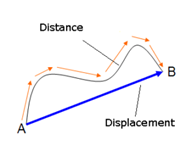Science > Physics > Motion in a Straight Line >Motion in a Straight Line Fill in the Blanks Questions

Fill in the Blanks
- If a body changes its position with respect to its surroundings, the body is said to be in …………..
If a body changes its position with respect to its surroundings, the body is said to be in motion.
Motion is a relative concept.
- The distance can never be ………., while displacement can be.
The distance can never be negative, while displacement can be.
Distance is always positive while displacement can be positive or negative or zero.
- If a body moves such that it covers equal distances in equal intervals of time, whatsoever be small, then the object is said to have …………. motion.
If a body moves such that it covers equal distances in equal intervals of time, whatsoever be small, then the object is said to have uniform motion.
- When a particle moves in a straight line from point A to point B the distance covered is ………. the magnitude of the displacement.
When a particle moves in a straight line from point A to point B the distance covered is equal to the magnitude of the displacement.
- Distance travelled divided by elapsed time gives ………….
Distance travelled divided by elapsed time gives speed.
- The ratio of the total displacement of a body to the total time taken is …………
The ratio of the total displacement of a body to the total time taken is velocity.
The average velocity of an object moving on a circle of radius R in one complete rotation if it takes t second in completing one rotation is …………..
The average velocity of an object moving on a circle of radius R in one complete rotation if it takes t second in completing one rotation is zero.
In one complete rotation displacement of the object is zero
Velocity = Displacement/time = 0/t = 0
- An object moving uniformly on a circular track. Its velocity ………. with time.
An object moving uniformly on a circular track. Its velocity changes with time.
In uniform circular motion, the speed (magnitude of velocity) is constant, but the direction of velocity changes continuously. Hence body in circular motion moves with acceleration.
- If particle is moving along circular path such that in equal interval of time it describes the equal angle, then velocity vector …………
If particle is moving along circular path such that in equal interval of time it describes the equal angle, then velocity vector changes its direction continuously.
The particle describes the equal angle in equal interval of time. Hence particle is in uniform circular motion. In uniform circular motion, the speed (magnitude of velocity) is constant, but the direction of velocity changes continuously.
- The magnitude of average velocity ………… equal to the average speed.
The magnitude of average velocity may or may not be equal to the average speed.
- When a body has unequal displacement in equal intervals of time, it is said to be moving with …………..
When a body has unequal displacement in equal intervals of time, it is said to be moving with non-uniform velocity.
- The acceleration of freely falling object is approximately equal to ……..
The acceleration of freely falling object is approximately equal to 9.8 ms-2.
- If a body starts from rest and moves with uniform acceleration, then its displacement is proportional to ………….
If a body starts from rest and moves with uniform acceleration, then its displacement is proportional to square of time.
s = ut + 1/2 at2
now u = 0
s = 1/2 at2
- A particle is just released to fall down from the top of a building. Its velocity at a particular position is directly proportional to …….
A particle is just released to fall down from the top of a building. Its velocity at a particular position is directly proportional to ………
A particle is just released to fall down from the top of a building. Its velocity at a particular position is directly proportional to time.
v = u + at
now u = 0
v = at
- All objects in free fall at a given place have the same
All objects in free fall at a given place have the same acceleration.
When the body falls freely under gravity, the acceleration produced in the body due to the gravitational force of attraction of the earth, then the acceleration by which the body falls down is called the acceleration of gravity.
- …………… acceleration is called retardation or deceleration.
Negative acceleration is called retardation or deceleration.
- A car is moving northward. The driver of the car applies brakes, the direction of acceleration is …………..
A car is moving northward. The driver of the car applies brakes, the direction of acceleration is southward.
When brakes are applied, the acceleration is negative and acts in the opposite direction to tht of motion at the instant of braking.
- A body moving with constant speed has zero acceleration only when the particle is in …… dimensional motion.
A body moving with constant speed has zero acceleration only when the particle is in one dimensional motion.
- In velocity-time graph, velocity is taken on ……… axis.
In velocity-time graph, velocity is taken on x-axis
- Area under velocity-time graph gives …………..
Area under velocity-time graph gives the displacement.
- The velocity-time graph of a moving object is a straight line parallel to the time axis. It means the velocity of the object is ………..
The velocity-time graph of a moving object is a straight line parallel to the time axis. It means the velocity of the object is constant.
- The velocity-time graph of a body moving with uniform velocity is a straight line parallel to …………..
The velocity-time graph of a body moving with uniform velocity is a straight line parallel to time axis.